Richard Liu
Mic-hackathon 2024: Hackathon on Machine Learning for Electron and Scanning Probe Microscopy
Jun 10, 2025Abstract:Microscopy is a primary source of information on materials structure and functionality at nanometer and atomic scales. The data generated is often well-structured, enriched with metadata and sample histories, though not always consistent in detail or format. The adoption of Data Management Plans (DMPs) by major funding agencies promotes preservation and access. However, deriving insights remains difficult due to the lack of standardized code ecosystems, benchmarks, and integration strategies. As a result, data usage is inefficient and analysis time is extensive. In addition to post-acquisition analysis, new APIs from major microscope manufacturers enable real-time, ML-based analytics for automated decision-making and ML-agent-controlled microscope operation. Yet, a gap remains between the ML and microscopy communities, limiting the impact of these methods on physics, materials discovery, and optimization. Hackathons help bridge this divide by fostering collaboration between ML researchers and microscopy experts. They encourage the development of novel solutions that apply ML to microscopy, while preparing a future workforce for instrumentation, materials science, and applied ML. This hackathon produced benchmark datasets and digital twins of microscopes to support community growth and standardized workflows. All related code is available at GitHub: https://github.com/KalininGroup/Mic-hackathon-2024-codes-publication/tree/1.0.0.1
WIR3D: Visually-Informed and Geometry-Aware 3D Shape Abstraction
May 07, 2025

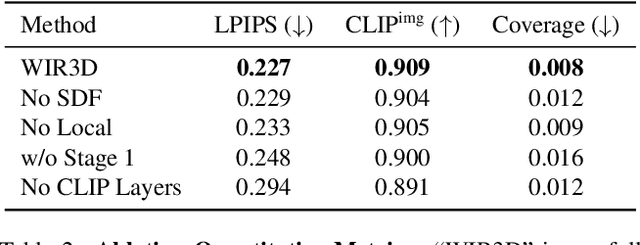
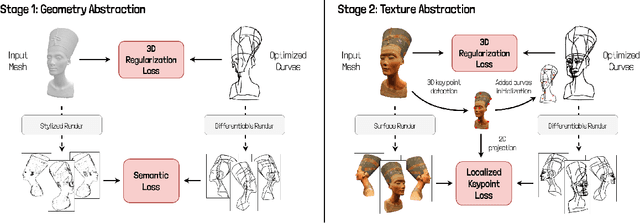
Abstract:We present WIR3D, a technique for abstracting 3D shapes through a sparse set of visually meaningful curves in 3D. We optimize the parameters of Bezier curves such that they faithfully represent both the geometry and salient visual features (e.g. texture) of the shape from arbitrary viewpoints. We leverage the intermediate activations of a pre-trained foundation model (CLIP) to guide our optimization process. We divide our optimization into two phases: one for capturing the coarse geometry of the shape, and the other for representing fine-grained features. Our second phase supervision is spatially guided by a novel localized keypoint loss. This spatial guidance enables user control over abstracted features. We ensure fidelity to the original surface through a neural SDF loss, which allows the curves to be used as intuitive deformation handles. We successfully apply our method for shape abstraction over a broad dataset of shapes with varying complexity, geometric structure, and texture, and demonstrate downstream applications for feature control and shape deformation.
Adaptive Self-Supervised Learning Strategies for Dynamic On-Device LLM Personalization
Sep 25, 2024



Abstract:Large language models (LLMs) have revolutionized how we interact with technology, but their personalization to individual user preferences remains a significant challenge, particularly in on-device applications. Traditional methods often depend heavily on labeled datasets and can be resource-intensive. To address these issues, we present Adaptive Self-Supervised Learning Strategies (ASLS), which utilizes self-supervised learning techniques to personalize LLMs dynamically. The framework comprises a user profiling layer for collecting interaction data and a neural adaptation layer for real-time model fine-tuning. This innovative approach enables continuous learning from user feedback, allowing the model to generate responses that align closely with user-specific contexts. The adaptive mechanisms of ASLS minimize computational demands and enhance personalization efficiency. Experimental results across various user scenarios illustrate the superior performance of ASLS in boosting user engagement and satisfaction, highlighting its potential to redefine LLMs as highly responsive and context-aware systems on-device.
General targeted machine learning for modern causal mediation analysis
Aug 26, 2024Abstract:Causal mediation analyses investigate the mechanisms through which causes exert their effects, and are therefore central to scientific progress. The literature on the non-parametric definition and identification of mediational effects in rigourous causal models has grown significantly in recent years, and there has been important progress to address challenges in the interpretation and identification of such effects. Despite great progress in the causal inference front, statistical methodology for non-parametric estimation has lagged behind, with few or no methods available for tackling non-parametric estimation in the presence of multiple, continuous, or high-dimensional mediators. In this paper we show that the identification formulas for six popular non-parametric approaches to mediation analysis proposed in recent years can be recovered from just two statistical estimands. We leverage this finding to propose an all-purpose one-step estimation algorithm that can be coupled with machine learning in any mediation study that uses any of these six definitions of mediation. The estimators have desirable properties, such as $\sqrt{n}$-convergence and asymptotic normality. Estimating the first-order correction for the one-step estimator requires estimation of complex density ratios on the potentially high-dimensional mediators, a challenge that is solved using recent advancements in so-called Riesz learning. We illustrate the properties of our methods in a simulation study and illustrate its use on real data to estimate the extent to which pain management practices mediate the total effect of having a chronic pain disorder on opioid use disorder.
Invariant Discovery of Features Across Multiple Length Scales: Applications in Microscopy and Autonomous Materials Characterization
Aug 01, 2024Abstract:Physical imaging is a foundational characterization method in areas from condensed matter physics and chemistry to astronomy and spans length scales from atomic to universe. Images encapsulate crucial data regarding atomic bonding, materials microstructures, and dynamic phenomena such as microstructural evolution and turbulence, among other phenomena. The challenge lies in effectively extracting and interpreting this information. Variational Autoencoders (VAEs) have emerged as powerful tools for identifying underlying factors of variation in image data, providing a systematic approach to distilling meaningful patterns from complex datasets. However, a significant hurdle in their application is the definition and selection of appropriate descriptors reflecting local structure. Here we introduce the scale-invariant VAE approach (SI-VAE) based on the progressive training of the VAE with the descriptors sampled at different length scales. The SI-VAE allows the discovery of the length scale dependent factors of variation in the system. Here, we illustrate this approach using the ferroelectric domain images and generalize it to the movies of the electron-beam induced phenomena in graphene and topography evolution across combinatorial libraries. This approach can further be used to initialize the decision making in automated experiments including structure-property discovery and can be applied across a broad range of imaging methods. This approach is universal and can be applied to any spatially resolved data including both experimental imaging studies and simulations, and can be particularly useful for exploration of phenomena such as turbulence, scale-invariant transformation fronts, etc.
HyperFields: Towards Zero-Shot Generation of NeRFs from Text
Oct 27, 2023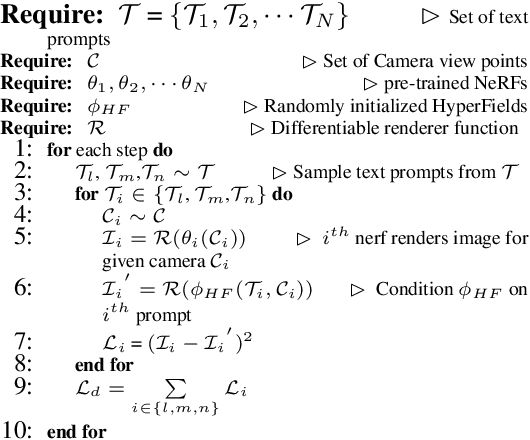


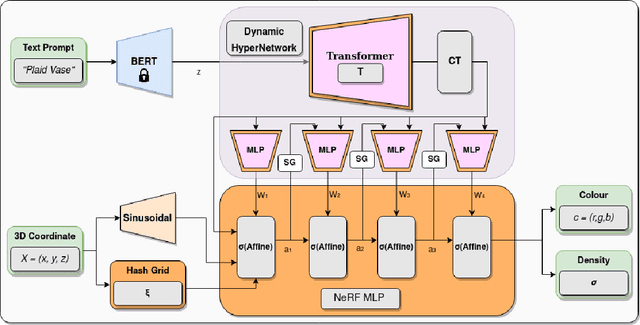
Abstract:We introduce HyperFields, a method for generating text-conditioned Neural Radiance Fields (NeRFs) with a single forward pass and (optionally) some fine-tuning. Key to our approach are: (i) a dynamic hypernetwork, which learns a smooth mapping from text token embeddings to the space of NeRFs; (ii) NeRF distillation training, which distills scenes encoded in individual NeRFs into one dynamic hypernetwork. These techniques enable a single network to fit over a hundred unique scenes. We further demonstrate that HyperFields learns a more general map between text and NeRFs, and consequently is capable of predicting novel in-distribution and out-of-distribution scenes -- either zero-shot or with a few finetuning steps. Finetuning HyperFields benefits from accelerated convergence thanks to the learned general map, and is capable of synthesizing novel scenes 5 to 10 times faster than existing neural optimization-based methods. Our ablation experiments show that both the dynamic architecture and NeRF distillation are critical to the expressivity of HyperFields.
TEDi: Temporally-Entangled Diffusion for Long-Term Motion Synthesis
Jul 29, 2023Abstract:The gradual nature of a diffusion process that synthesizes samples in small increments constitutes a key ingredient of Denoising Diffusion Probabilistic Models (DDPM), which have presented unprecedented quality in image synthesis and been recently explored in the motion domain. In this work, we propose to adapt the gradual diffusion concept (operating along a diffusion time-axis) into the temporal-axis of the motion sequence. Our key idea is to extend the DDPM framework to support temporally varying denoising, thereby entangling the two axes. Using our special formulation, we iteratively denoise a motion buffer that contains a set of increasingly-noised poses, which auto-regressively produces an arbitrarily long stream of frames. With a stationary diffusion time-axis, in each diffusion step we increment only the temporal-axis of the motion such that the framework produces a new, clean frame which is removed from the beginning of the buffer, followed by a newly drawn noise vector that is appended to it. This new mechanism paves the way towards a new framework for long-term motion synthesis with applications to character animation and other domains.
DA Wand: Distortion-Aware Selection using Neural Mesh Parameterization
Dec 14, 2022Abstract:We present a neural technique for learning to select a local sub-region around a point which can be used for mesh parameterization. The motivation for our framework is driven by interactive workflows used for decaling, texturing, or painting on surfaces. Our key idea is to incorporate segmentation probabilities as weights of a classical parameterization method, implemented as a novel differentiable parameterization layer within a neural network framework. We train a segmentation network to select 3D regions that are parameterized into 2D and penalized by the resulting distortion, giving rise to segmentations which are distortion-aware. Following training, a user can use our system to interactively select a point on the mesh and obtain a large, meaningful region around the selection which induces a low-distortion parameterization. Our code and project page are currently available.
A neural net architecture based on principles of neural plasticity and development evolves to effectively catch prey in a simulated environment
Jan 31, 2022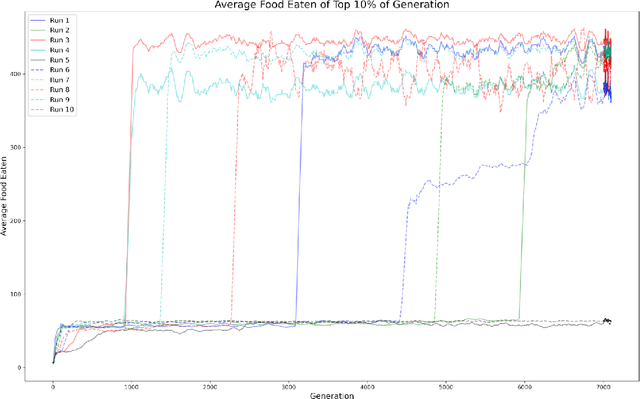
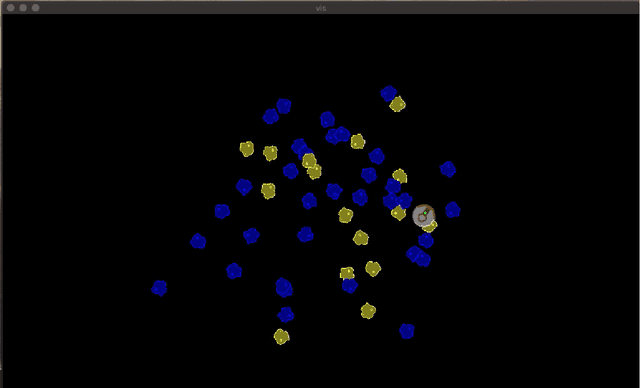
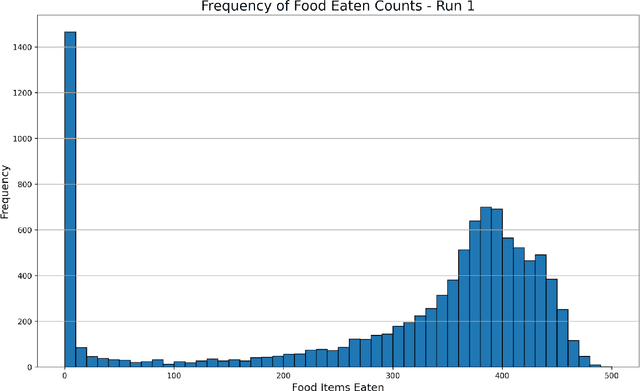
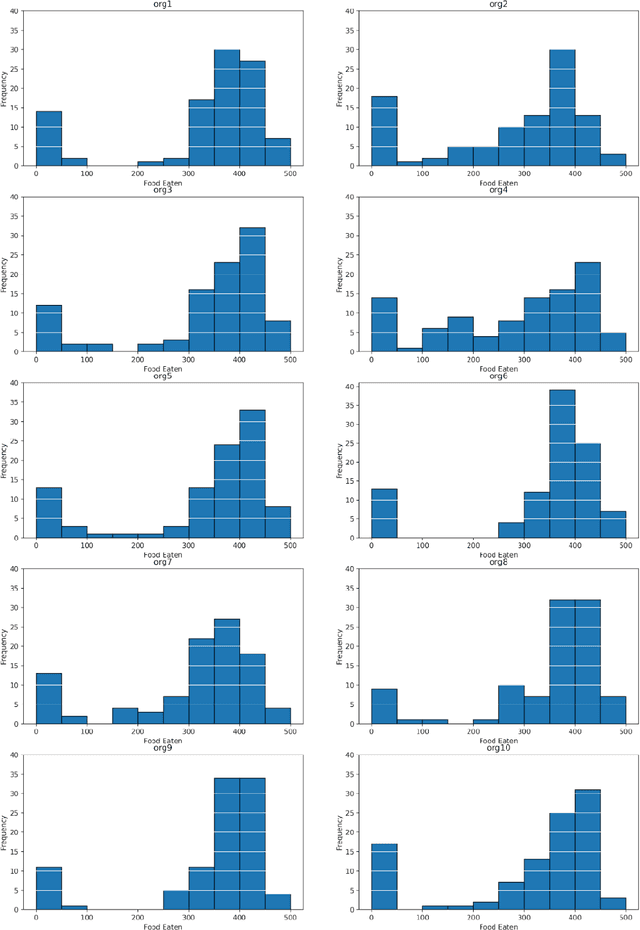
Abstract:A profound challenge for A-Life is to construct agents whose behavior is 'life-like' in a deep way. We propose an architecture and approach to constructing networks driving artificial agents, using processes analogous to the processes that construct and sculpt the brains of animals. Furthermore the instantiation of action is dynamic: the whole network responds in real-time to sensory inputs to activate effectors, rather than computing a representation of the optimal behavior and sending off an encoded representation to effector controllers. There are many parameters and we use an evolutionary algorithm to select them, in the context of a specific prey-capture task. We think this architecture may be useful for controlling small autonomous robots or drones, because it allows for a rapid response to changes in sensor inputs.
Text2Mesh: Text-Driven Neural Stylization for Meshes
Dec 06, 2021
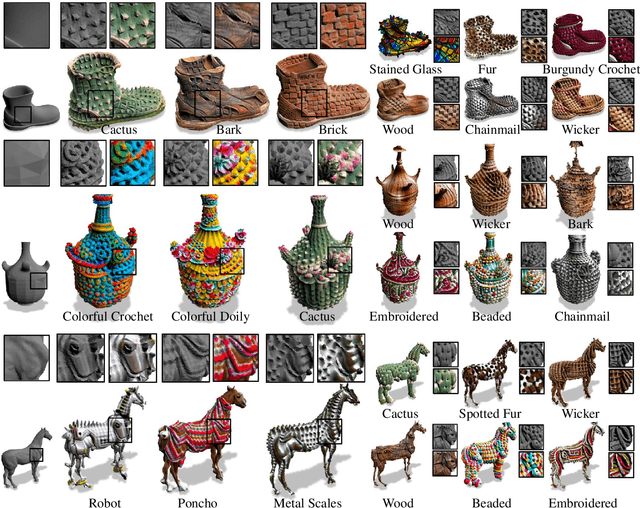
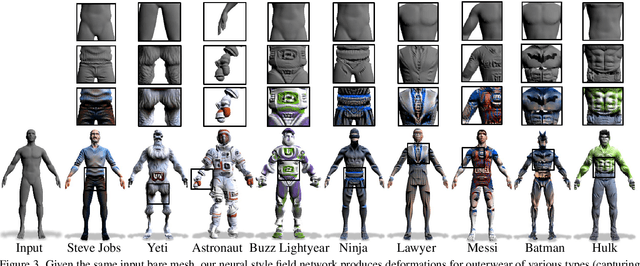
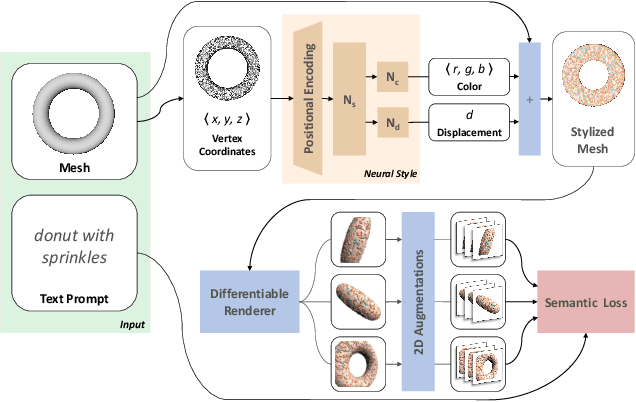
Abstract:In this work, we develop intuitive controls for editing the style of 3D objects. Our framework, Text2Mesh, stylizes a 3D mesh by predicting color and local geometric details which conform to a target text prompt. We consider a disentangled representation of a 3D object using a fixed mesh input (content) coupled with a learned neural network, which we term neural style field network. In order to modify style, we obtain a similarity score between a text prompt (describing style) and a stylized mesh by harnessing the representational power of CLIP. Text2Mesh requires neither a pre-trained generative model nor a specialized 3D mesh dataset. It can handle low-quality meshes (non-manifold, boundaries, etc.) with arbitrary genus, and does not require UV parameterization. We demonstrate the ability of our technique to synthesize a myriad of styles over a wide variety of 3D meshes.
 Add to Chrome
Add to Chrome Add to Firefox
Add to Firefox Add to Edge
Add to Edge